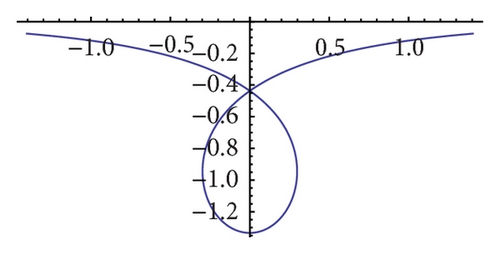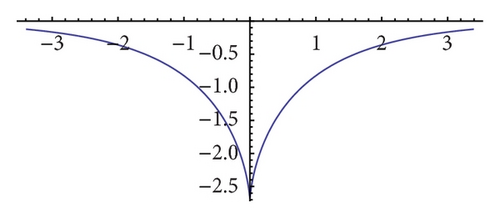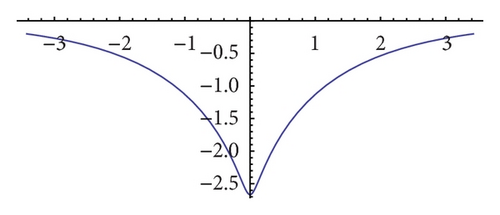Analytical and Multishaped Solitary Wave Solutions for Extended Reduced Ostrovsky Equation
Abstract
We present the analytical and multishaped solitary wave solutions for extended reduced Ostrovsky equation (EX-ROE). The exact solitary (traveling) wave solutions are expressed by three types of functions which are hyperbolic function solution, trigonometric function solution, and rational solution. These results generalized the previous results. Multishape solitary wave solutions such as loop-shaped, cusp-shaped, and hump-shaped can be obtained as well when the special values of the parameters are taken. The (G′/G)-expansion method presents a wide applicability for handling nonlinear partial differential equations.
1. Introduction
Parkes [3] has studied (2) and found its periodic and solitary traveling wave solutions.
The EX-ROE has been studied by several researchers. For example, Liu et al. [13] used Jacobi elliptic function method to obtain exact double periodic wave solutions and solitary wave solutions. Parkes [4] constructed periodic and solitary wave solutions of EX-ROE and gave the categorization of the solutions. Xie and Cai [14] used the bifurcation method of dynamic systems and simulation method of differential equations to get exact compacton and generalized kink wave solutions of EX-ROE. Stepanyants [15] applied the qualitative theory of differential equations to give a full classification of its solutions.
Recently, there are many methods being proposed to study the traveling wave solutions of nonlinear partial differential equations which are derived from physics, for example, [16–27]. As well as these methods, there are still many other methods; we cannot list all of them. Here we will use modified (G′/G)-expansion method to investigate EX-ROE. As a result, three types of traveling wave solutions are were obtained. When the special values of the parameters are taken, they are reduced to some previous results which obtained by an other method.
The rest of the paper is organized as follows. In Section 2, we present a methodology of the modified (G′/G)-expansion method. In Section 3, we apply the method to the extended reduced Ostrovsky equation. In Section 4, some conclusions are given.
2. Description of the Modified (G′/G)-Expansion Method
The (G′/G)-expansion method is first proposed by Wang et al. [28]. The useful (G′/G)-expansion method is then widely used by many authors [29–32]. Then it is modified in [33–35]. The main steps are as follows.
Step 1. The traveling wave variable u(x, t) = u(ξ), ξ = x − ct, where c is a constant, permits us to reduce (10) to an ODE for u = u(ξ) in the form
Step 2. Suppose that the solution of (10) can be expressed by a polynomial in (G′/G) as follows:
Step 3. Substituting (12) into (11) and using (13), collecting all terms with the same order of (G′/G) together, and then equating each coefficient of the resulting polynomial to zero yields a set of algebraic equations for αm, αm−1, …, α−m, c, λ, and μ.
Step 4. Since the general solutions of (13) have been well known for us, then substituting αm, αm−1, …, α−m and c and the general solutions of (13) into (12) we have more traveling wave solutions of the nonlinear differential equation (10).
The main idea of (G′/G)-expansion method is to use an integrable ODE to expand a solution to a nonlinear partial differential equation (PDE) as a polynomial or rational function of the solution of the ODE. However, such an idea was also presented in [36–38]. The method used in this paper can be also thought of as the application of transformed rational function method used in [37] in some sense. Maybe the similar results can be obtained by using these very closely related methods. We plan to further study the EX-ROE in near future by using the methods proposed in [36–38]. We hope we can find much more interesting properties and new phenomenon of this equation.
3. Exact Traveling Wave Solutions of the Extended Reduced Ostrovsky Equation
In this section, we will use the (G′/G)-expansion method to the extended reduced Ostrovsky equation to get exact traveling wave solutions.
Since the general solutions G = G(ξ) (hence G′ = dG/dξ) of ODE (19) have been known for us, substituting the solutions of (19) into (24) and (25), we have the general traveling wave solutions of (15) as follows.
Case 1. When λ2 − 4μ > 0, then we have the following exact traveling wave solution of (15):
Case 2. When λ2 − 4μ < 0, then we have the following exact traveling wave solution of (15):
Case 3. When λ2 − 4μ = 0, then we have the following exact rational solution of (15):
Now we will show how to get exact traveling wave solutions of (6). From (8) and (14), the solution of EX-ROE (6) is given in parametric form, with T as the parameter, by
4. Multishaped Solitary Wave Solutions
In [8, 13], the authors showed that the solutions of (4.4) and (4.5), (3.26) and (3.28) may be of different types, namely, loops, cusps, or humps for different values of parameters β, k, p. Here we also show that by choosing different values of the parameters β, λ, p, q, different shape wave solutions can be obtained. As it is stated in Section 1, (9) reduces to VE when p = q = 1, β = 0. Taking solution (42) with (43), for example, let p = q = 1, β = 0, λ = 2k; then it is reduced to one-loop soliton solution (3.4) and (3.5) in [39]. On the other hand, because the solutions of OHE and VE are connected in a particularly simple way, if we take p = q = −1, β = 0, λ = 2k in (42), we can obtain one-loop soliton solution of OHE.
From above analysis, one can clearly see that the solutions obtained in this paper are generalized for the previous results because here we only take the special case A1 = 0, μ = 0, A2 ≠ 0, λ > 0 and give special discussion of solution (42). We conclude that if we take different values of the parameters A1, A2, λ, μ, p, q, abundancy of types of exact solutions can be obtained from solutions (36), (38), and (40). Here we omit the detailed discussion.



5. Conclusion
In this paper, we use (G′/G)-expansion method to study extended reduced Ostrovsky equation. Several pairs of generalized traveling wave solutions are given directly. These solutions extend the previous results to more general cases. At the same time, multishaped wave solutions can be obtained if the different parameters values are chosen. These explicit solitary wave solutions own the property of being loop-shaped, cusp-shaped, and hump-shaped. These exact traveling wave solutions are also helpful to further study this nonlinear equation which has their physical meaning. The method used in this paper has more advantages. It is direct and concise. Much tedious algebraic calculations can be finished by computer program such as MATHEMATICA and MAPLE. Many well-known nonlinear wave equations can be handled by this method.
Acknowledgment
The authors thank anonymous referees for valuable suggestions and comments which improve this paper readability and convincibility. This paper is supported by the Starting Research Founding of Wuhan Textile University.




